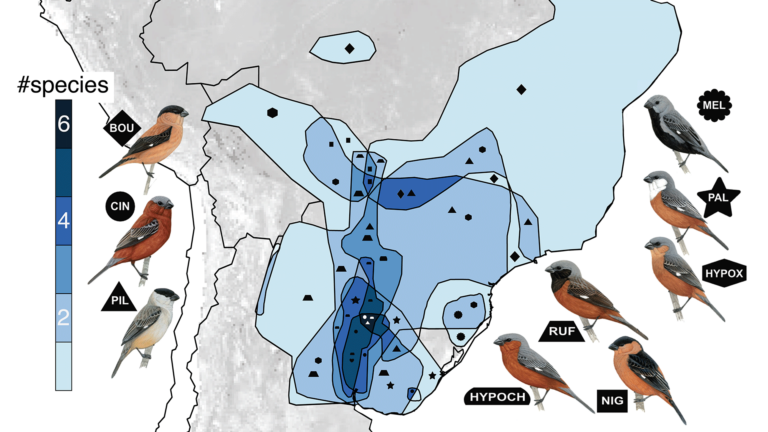Nearly 200 years ago, Charles Darwin noted striking diversity among the finches of the Galapagos Islands, and his observations helped him propose the role of natural selection in shaping species. Today, some biologists focus their attention on a related group of birds, the finch-like capuchino seedeaters of South America, and their studies are deepening our understanding of the forces that drive evolution.

Capuchino seedeaters are of interest to evolutionary biologists because they have diversified from their common ancestor relatively recently. Each species has characteristic plumage and its own song. Differences are caused by lots of variations in only a few dozen spots in otherwise remarkably similar genomes. These small genetic “islands of differentiation” distinguish each species early in their evolutionary split from one another. Over time, as the species diverge more, researchers expect more of their genomes to change.
A few years ago, Leo Campagna and Irby Lovette at Cornell determined that many of these islands affected pigment production genes. In the current study, Siepel’s group collaborated with Campagna and Lovette to identify additional differentiation sites and investigate their causes.
Two different genetic processes can create islands of differentiation: selective sweeps or a genetic incompatibility limiting the passage of specific segments of DNA within a population. Computational tools developed in Siepel’s lab allowed his team, led by postdoctoral researcher Hussein Hejase, to discriminate between these possibilities. Comparing the genomes of 60 birds from five species confirmed that most of the islands of differentiation that separate today’s seedeater species arose due to selective sweeps.
Notably, Siepel explained, most of these appear to be due to soft selective sweeps:
“The soft sweep acts on a variant that already exists in the population. But that variant newly becomes under selective pressure, maybe because of a change of environment, a new predator, a new food, whatever. Or in this case, we think in many cases because of sexual selection, because the birds of the opposite sex found some aspect of that variant attractive, whether it’s its coloration or song, and that helped push it to high frequency.”
Siepel said the finding shows that even quite striking islands of genetic differentiation can be explained by soft sweeps that acted separately on newly emerging species.
Written by: Jennifer Michalowski, Science Writer | publicaffairs@cshl.edu | 516-367-8455
Funding
U.S. National Science Foundation, U.S.-Israel Binational Science Foundation, and the National Institutes of Health.
Citation
Hejase, H.A., et al. “Genomic islands of differentiation in a rapid avian radiation have been driven by recent selective sweeps”, PNAS, November 16, 2020. DOI: 10.1073/pnas.2015987117
Principal Investigator

Adam Siepel
Professor
Cancer Center Member
Ph.D., University of California, Santa Cruz, 2005

